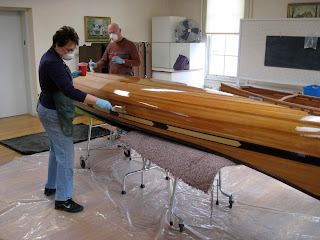Preparation.
To get a good finish requires a good deal of preparation. The music stand as received was in great shape - very little sanding was going to be required. However, there were certain to be some random spots of glue left behind from the assembly process. I had raised the grain with a damp sponge and gone over it with paper when dry before she'd received it, but I knew that I hadn't gotten all of the glue spots. So yesterday, when she wanted to start finishing the piece, I told DD to take and sand it all over with some 320 grit wet-or-dry sandpaper looking for spots of glue and rough areas. I told her to let me know when she thought she was done.
All-in-all, she'd done a good job and I only touched up a few spots that I could feel were still a bit rough when I ran my hands over the piece. We're using Watco's natural oil finish on this as it is more forgiving than a hard finish for DD to work with. She can wipe it on and wipe the excess off with ease. As the first coat went on, she could feel some rough spots that were still there and we found some more glue spots that had been missed. A piece of the 320 grit paper quickly solved those issues and banished any trace of glue.
Here's the head, precariously balanced on a piece of cardboard with the adjustment pegs barely visible to the left.
Here is the base - still waiting for another coat or two of finish.
I try to impress upon the canoe builders in my class that preparation is the key to a good finish as well. The couple building the Prospector Ranger 15 were a bit frustrated by the amount of scraping and sanding that they did before finishing the outside of the hull. They spent about two and a half class sessions doing this work to prepare the surface. They were tired and, "just want to be done". So, after scraping, sanding and inspecting the hull, they brought it up to the dust free area upstairs from the shop and wiped the hull down with denatured alcohol to prepare the surface. As they applied the first coat of spar varnish to the hull, the beauty began to shine through.
While people may think I'm a task-master when I tell them to go back and do a bit more sanding or a bit more scraping, I think they find that it is worth it in the end. There's no substitute for good preparation.























